第六讲 句法翻译
- 格式:ppt
- 大小:102.00 KB
- 文档页数:23


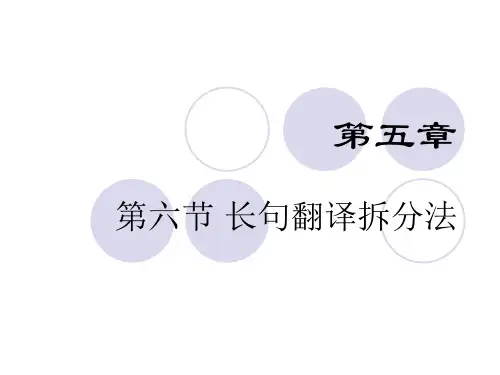
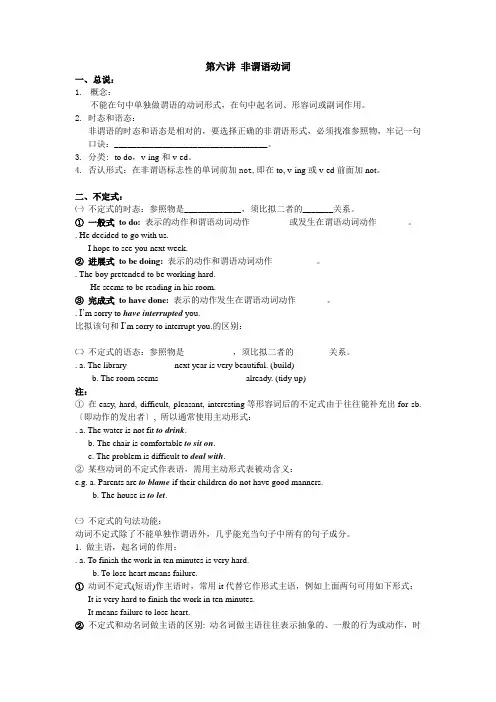
第六讲非谓语动词一、总说:1.概念:不能在句中单独做谓语的动词形式,在句中起名词、形容词或副词作用。
2. 时态和语态:非谓语的时态和语态是相对的,要选择正确的非谓语形式,必须找准参照物,牢记一句口诀:___________________________________。
3. 分类: to do,v-ing和v-ed。
4. 否认形式:在非谓语标志性的单词前加not,即在to, v-ing或v-ed前面加not。
二、不定式:㈠不定式的时态:参照物是_____________,须比拟二者的_______关系。
①一般式to do:表示的动作和谓语动词动作_________或发生在谓语动词动作_______。
. He decided to go with us.I hope to see you next week.②进展式to be doing: 表示的动作和谓语动词动作__________。
. The boy pretended to be working hard.He seems to be reading in his room.③完成式to have done: 表示的动作发生在谓语动词动作_______。
. I’m sorry to have interrupted you.比拟该句和I’m sorry to interrupt you.的区别:㈡不定式的语态:参照物是___________,须比拟二者的________关系。
. a. The library __________ next year is very beautiful. (build)b. The room seems ___________________ already. (tidy up)注:①在easy, hard, difficult, pleasant, interesting等形容词后的不定式由于往往能补充出for sb.〔即动作的发出者〕, 所以通常使用主动形式:. a. The water is not fit to drink.b. The chair is comfortable to sit on.c. The problem is difficult to deal with.②某些动词的不定式作表语,需用主动形式表被动含义:e.g. a. Parents are to blame if their children do not have good manners.b. The house is to let.㈢不定式的句法功能:动词不定式除了不能单独作谓语外,几乎能充当句子中所有的句子成分。
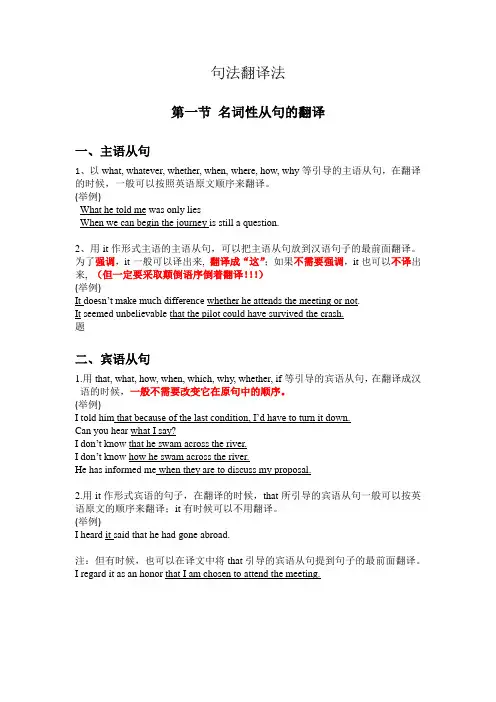
句法翻译法第一节名词性从句的翻译一、主语从句1、以what, whatever, whether, when, where, how, why等引导的主语从句,在翻译的时候,一般可以按照英语原文顺序来翻译。
(举例)What he told me was only liesWhen we can begin the journey is still a question.2、用it作形式主语的主语从句,可以把主语从句放到汉语句子的最前面翻译。
为了强调,it一般可以译出来, 翻译成“这”;如果不需要强调,it也可以不译出来, (但一定要采取颠倒语序倒着翻译!!!)(举例)It doesn’t make much difference whether he attends the meeting or not.It seemed unbelievable that the pilot could have survived the crash.题二、宾语从句1.用that, what, how, when, which, why, whether, if等引导的宾语从句,在翻译成汉语的时候,一般不需要改变它在原句中的顺序。
(举例)I told him that because of the last condition, I’d have to turn it down.Can you hear what I say?I don’t know that he swam across the river.I don’t know how he swam across the river.He has informed me when they are to discuss my proposal.2.用it作形式宾语的句子,在翻译的时候,that所引导的宾语从句一般可以按英语原文的顺序来翻译;it有时候可以不用翻译。
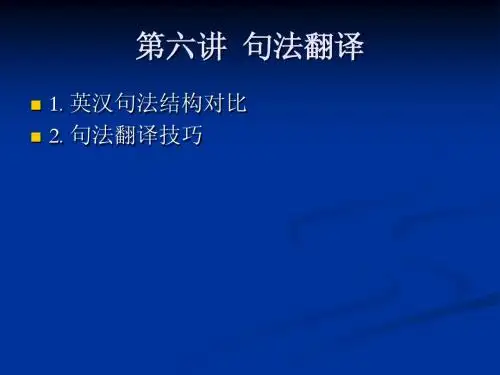
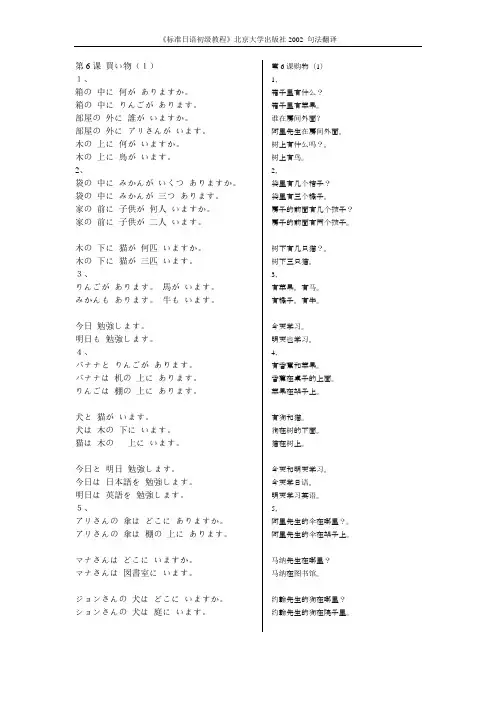
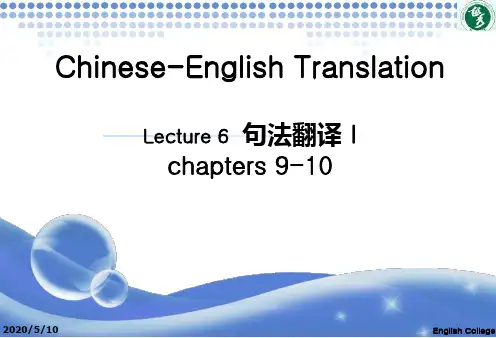
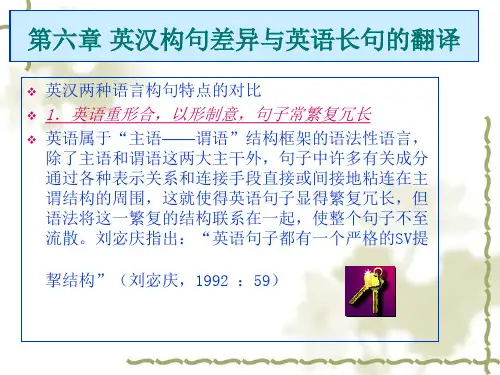


句法翻译- -英语和汉语在于法结构上差异很大,在翻译过程中,需要经常更换原文词语的前后顺序。
翻译是根据译文的语言习惯,对原文的词序进行调整,是译文做到最大程度上的通顺,这就是换序译法。
若照搬原文的词序,不顾译文语言的习惯,这样的翻译绘滑稽可笑,毫无通顺可言,因而译文也不信,违反翻译的标准。
翻译世纪要避免生硬的死译,也要避免不顾原文的现象。
一、换序翻译英语和汉语在于法结构上差异很大,在翻译过程中,需要经常更换原文词语的前后顺序。
翻译是根据译文的语言习惯,对原文的词序进行调整,是译文做到最大程度上的通顺,这就是换序译法。
若照搬原文的词序,不顾译文语言的习惯,这样的翻译绘滑稽可笑,毫无通顺可言,因而译文也不信,违反翻译的标准。
翻译世纪要避免生硬的死译,也要避免不顾原文的现象。
例子见P.81。
1.Even the wild animals of his homeland, it seemed to Kunta, had more dignity than these creatures. (Alex Haley, Roots)昆他觉得,即使他家乡的野兽也比这群人自尊自重。
(插入语换序)。
2.From the moment they set foot on the territory of their motherland, they were warmly received by their compatriots. 他们从走上祖国土地的时刻起,就受到同胞们热情接待。
(定语从句换序)3.Cheerful, efficient and warm-hearted, they will do everything to make your journey smooth and comfortable. 他们乐观、能干、热情,总是想方设法使你一路上顺利舒适。
(状语易位,并转变为谓语)。
4.Don't hesitate to come when you need help. 你们什么时候需要我,只管来找我。
第六章:句法翻译正反译法;转态译法;否定译法;换序译法;断句译法;合句译法;转句译法;缩句译法。
一、正反翻译:(反说:含否定词; 正说:不含否定词)●That’s a thing that might happen to any man. 这种事情谁也难免。
●Private. 闲人莫入。
●Keep upright. 切勿倒置。
●Urban clearway. 市区通道,不准停车。
●Keep off the lawn!请勿践踏草地!●He was the last man to say such things.译文:他绝不会说这样的话。
●I couldn’t agree more with you.译文:我完全同意你的看法。
●法律面前,人人平等。
译文:Law is no respecter of persons.(一)反说正译●All man between 18 and 45 without exception are expected to servein the army during the war. 战时凡年在18至45之间的男子应一律服兵役。
该规则没有例外。
●No deposit will be refunded unless ticket produced.凭票退换押金。
(二)正说反译●I have fallen behind with my correspondence. 我有一些信件没有及时答复。
●The plane cracked up through a bad landing.飞机因着陆不慎而坠毁。
●他们每次见面都要谈论那件事。
(三)视角转换●在美国,人人都能买到枪。
译文1:In the United States, everyone can buy a gun.译文2:In the United States, guns are available to everyone.●The darkness was thinning, but they were still in bed.天渐渐有些亮了,但他们还在睡觉。